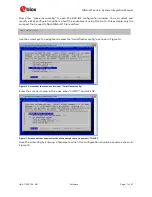
NINA-W1 series - System Integration Manual
UBX-17005730 - R07
Design-in
Page 30 of 47
Figure 24: Example of RF trace and ground design from NINA-W1 Evaluation Kit (EVK)
3.3.2
Antenna design (NINA-W101/W131/W151)
NINA-W101/W131/W151 is suited for designs when an external antenna is needed due to
mechanical integration or placement of the module.
Designers must take care of the antennas from all perspective at the beginning of the design phase
when the physical dimensions of the application board are under analysis/decision, as the RF
compliance of the device integrating NINA-W1 module with all the applicable required certification
schemes heavily depends on the radiating performance of the antennas. The designer is encouraged
to consider one of the u-blox suggested antenna part numbers and follow the layout requirements.
•
External antennas such as linear monopole:
o
External antennas basically do not imply physical restriction to the design of the PCB
where the module is mounted.
o
The radiation performance mainly depends on the antennas. It is required to select
antennas with optimal radiating performance in the operating bands.
o
RF cables should be carefully selected with minimum insertion losses. Additional
insertion loss will be introduced by low quality or long cable. Large insertion loss reduces
radiation performance.
o
A high quality 50
Ω
coaxial connector provides proper PCB-to-RF-cable transition.
•
Integrated antennas such as patch-like antennas:
o
Internal integrated antennas imply physical restriction to the PCB design:
Integrated antenna excites RF currents on its counterpoise, typically the PCB ground
plane of the device that becomes part of the antenna; its dimension defines the
minimum frequency that can be radiated. Therefore, the ground plane can be reduced
down to a minimum size that should be similar to the quarter of the wavelength of the
minimum frequency that has to be radiated, given that the orientation of the ground
plane related to the antenna element must be considered.
The RF isolation between antennas in the system has to be as high as possible and the
correlation between the 3D radiation patterns of the two antennas has to be as low as
possible. In general, an RF separation of at least a quarter wavelength between the two
antennas is required to achieve a maximum isolation and low pattern correlation;
















































